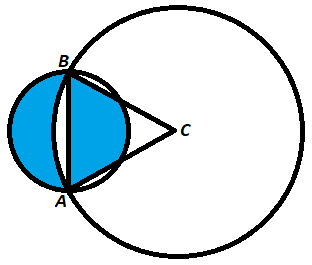Who Ate My Pi?
In the diagram, is the diameter of the small circle, and are radii of the big circle, and . Find the area of the blue region.

The answer is 9.
This section requires Javascript.
You are seeing this because something didn't load right. We suggest you, (a) try
refreshing the page, (b) enabling javascript if it is disabled on your browser and,
finally, (c)
loading the
non-javascript version of this page
. We're sorry about the hassle.
Let A B = B C = A C = 2 4 1 2 = 2 r . r = 4 1 2 . We note that the top and down segments (in white) of the small circle are identical. The area of one of this small segment is
A 1 = Area of 6 0 ∘ sector − Area of equilateral triangle = 6 π r 2 − 2 1 r 2 sin 6 0 ∘ = 6 π r 2 − 4 3 r 2
Since the big segment A B (in white) of the big circle has a radius of 2 r , its area is \(A_2 = 2^2A_1 = 4A_1). And the area of the blue area is given by:
\(\begin{align} A_1 & = \text{Area of the }{\color{blue}\text{blue }} \text{circle} - 2A_1 - \color{blue}A_2 & \small \color{blue} \text{Since }A_2 = 4A_1 \\ & = \pi r^2 - 6A_1 \\ & = \pi r^2 - 6 \left(\frac {\pi r^2}6 - \frac {\sqrt 3 r^2}4\right) \\ & = \frac {3 \sqrt 3 r^2}2 \\ & = \frac {3\sqrt 3}2 \left(\sqrt[4]{12}\right)^2 \\ & = \frac {3\sqrt 3}2 \left(2\sqrt 3\right) \\ & = \boxed 9 \end{align} \)